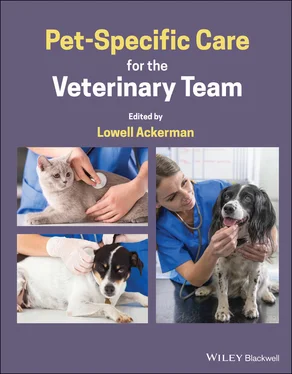Genotype:The DNA of the animal. Usually pertaining to the two copies of a single gene, (i.e., AA, aa, or Aa).
Heterozygous:A gene pair where the two copies have different alleles (i.e., Aa).
Homozygous:A gene pair where both copies have the same allele (i.e., AA or aa).
Phenotype:What you see in the animal based on the expression of the genotype (i.e., normal, affected, coat type, etc.).
 MAIN CONCEPTS
MAIN CONCEPTS
Genetic testing does not just involve breeding animals. We see genetic disease in practice every day. Every nucleated cell in the body has the same DNA instruction manual. Cells in different tissues have different genes turned on and off to control their maturation and function. Genes get turned on and off, and their effects are mitigated based on the effect of other genes, diet, drugs, inflammation, infection, and surgery.
All genes come in pairs – one from the sire and one from the dam (see 3.1Genetic Basics). Simple Mendelian genetic diseases are caused by the effects of only one gene pair. Dominant disease can be caused by one mutated gene in the pair, and recessive disease requires two mutated genes. Sex‐linked/X‐linked disease involves genes on the X chromosome. As males have only one X chromosome, any mutation on the X chromosome can cause disease. Females, with two X chromosomes, can be carriers of recessive disease with one copy of a mutation, or can be affected if they have two copies (see 3.2Modes of Inheritance).
Complexly inherited disease, also referred to as polygenically inherited traits, involves the combined effect of multiple gene pairs and usually an environmental component. The majority of genetic diseases and the most commonly seen diseases (e.g., hip dysplasia, feline inflammatory bladder disease, allergies, hypothyroidism, etc.) are complexly inherited and currently have no mutation‐based DNA tests available.
Genetic tests vary on what they are able to identify, and therefore how they can be used in managing genetic disease. To understand how we can use genetic tests, we have to understand the types of tests that are available, what they can tell us, and their limitations (see 3.11Integrating Genotypic and Phenotypic Testing).
Some tests measure the phenotype, or what can be seen in the animal. This may not directly relate to the genotype, or the genes regulating the defect that you are trying to manage. Ophthalmic screening for cataracts, auscultating for heart murmurs, hip and elbow radiographs, thyroid profiles, bile acid tests, eye examinations, urinalysis for crystals or metabolites, bladder stone analysis, skin biopsy for sebaceous adenitis, and observations on behavioral traits are all tests of the phenotype. Most tests of the phenotype only identify affected individuals from nonaffected individuals, and not carriers of disease liability genes (see 3.3The Genetics of Disease).
These tests identify specific DNA sequences and nucleotide changes. They can be run at any age, often before the onset of clinical disease. Different types of genotypic tests reflect the research that identified them. Candidate gene studies or whole‐genome sequencing (WGS) usually identify specific disease‐causing mutations. In genome‐wide association studies (GWAS), groups of affected and normal individuals are compared at the DNA level. A SNP (pronounced snip ) is a single nucleotide polymorphism – a single DNA letter (A, T, C, or G) that varies between individuals. GWAS utilizes gene chips that can evaluate hundreds of thousands of different SNPs. A SNP that is always present in a disease state but not in normal animals is considered a marker that lies close on the chromosome to a disease‐causing gene. In some instances, the SNP is a single nucleotide substitution that actually causes the disease.
3.6.4.1 Direct Mutation‐Based Tests
These tests evaluate for specific disease‐causing gene mutations. For completely penetrant simple Mendelian genes, an “affected” test result is 100% accurate in predicting clinical disease. For recessive disorders requiring two copies of the mutation to be affected, these tests allow identification of “carriers” who have one copy of the mutation, while “normal” individuals have no copies of the mutation.
If a direct mutation test does not predict disease 100% of the time, then this is considered incomplete penetrance (i.e., the genotype does not penetrate into the phenotype completely and consistently). This decreased penetrance can be due to the effect of other genes that impact their expression (complex or polygenic inheritance). For late‐onset disorders, variations in age of onset can affect penetrance if the “average” age of onset is close to the average life expectancy of the individual. Examples would be late‐onset cataracts, some forms of progressive retinal atrophy (PRA), and several neurodegenerative disorders.
Some direct genetic tests identify a mutation that causes increased susceptibility to a genetic disease, but is not necessarily associated with disease 100% of the time. These susceptibility or liability genes can be part of complexly inherited diseases or the cause of incomplete penetrance of (assumed) simple Mendelian diseases. Some of these mutations are required for an individual to be affected, and some just provide increased risk (increased odds ratio), if present, but are not required to produce an affected individual. An example is the susceptibility to perianal fistulae/anal furunculosis in German shepherd dogs. Dogs with the susceptibility haplotype (combination of major histocompatibility complex [MHC] genes) have a 5× odds ratio for the disease versus those without the haplotype. This means that individuals with a positive test result are five times more likely to develop the disease than animals that do not test positive. This risk factor occurs whether the susceptibility haplotype is heterozygous or homozygous, though homozygous dogs develop the disease at an earlier age. Another example is the genetic test for pug dog encephalitis, a painful, fatal disease affecting 1–2% of pugs. Dogs homozygous for an MHC susceptibility haplotype have a 15.6× odds ratio for developing the disease, but dogs heterozygous for the susceptibility haplotype have no greater risk.
3.6.4.2 Linked Marker‐Based Tests
Some defective genes can be linked to a genetic marker – usually a SNP. The causative gene for the disorder in this case has not actually been identified, but a marker is available that can provide at least some predictive ability. Because the mutation and linked marker lie on the same chromosomal segment, they are usually inherited together, and the marker is relatively (but not absolutely) predictive of the presence of the disease mutation. During meiosis in the formation of eggs and sperm, the maternal and paternal paired chromosomes can cross over and exchange DNA segments. If a genetic cross‐over occurs between a linked marker and the defective gene, the marker will no longer be linked to the defective gene. False‐positive and false‐negative results will occur and allow the marker to be passed on to offspring and descendants. Due to this phenomenon, linked marker test results must be compared with results from other family members to determine whether they correlate with their known phenotype.
3.6.4.3 Breed‐Specific Genetic Testing
Due to common inheritance, different breeds of cats and dogs can be more prone to certain hereditary diseases. These can occur as a higher prevalence of common genetic diseases such as allergies, hip dysplasia, or feline urological syndrome/inflammatory cystitis. Other breed‐related diseases are caused by more recent mutations that are only present in a specific breed or group of related breeds.
Читать дальше

 MAIN CONCEPTS
MAIN CONCEPTS










